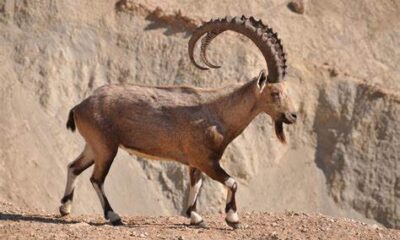Article
K2: The Savage Beauty at 8,611 Meters – The World’s Second Highest Mountain
Published
9 months agoon
By
EDITOR
K2, the majestic giant standing at 8,611 meters (28,251 feet), is not only the second-highest mountain in the world but also one of the most formidable and revered peaks on the planet. Located in the Karakoram Range of northern Pakistan, along the border with China, K2 has earned the nickname “The Savage Mountain” for its extreme difficulty and high fatality rate among climbers. Despite its breathtaking beauty, K2 remains one of the most dangerous and challenging mountains to conquer.
Geographical Significance of K2
K2 is situated in the Karakoram Range, part of the greater Himalayan mountain system. Unlike Mount Everest, which is surrounded by relatively gentle terrain, K2 rises sharply from its base, with jagged ridges and steep slopes, making it a climber’s nightmare. It is part of the Baltoro Glacier region, which is known for its spectacular landscapes and other towering peaks, such as Broad Peak and the Gasherbrum mountains.
This region of Pakistan is renowned for its unparalleled natural beauty, with K2 standing as the centerpiece of the Karakoram’s icy grandeur. The sheer vertical rise of K2 from its base adds to its imposing nature, making it an iconic symbol of raw, untouched wilderness.
The History of K2: A Climbers’ Dream and Challenge
The first attempt to climb K2 was made in 1902 by an international team led by British climber Oscar Eckenstein. However, the mountain’s treacherous conditions, including severe weather and technical difficulties, thwarted early efforts. It wasn’t until July 31, 1954, that an Italian expedition led by Achille Compagnoni and Lino Lacedelli successfully summited K2, making it the first recorded ascent of this fearsome peak.
Since then, K2 has attracted climbers from all over the world, but the mountain’s unforgiving nature has made it one of the most dangerous peaks to summit. One out of every four climbers who attempts K2 does not return, a grim statistic that reflects the mountain’s lethal combination of high altitude, avalanches, and unpredictable weather. The narrow window for safe climbing on K2 is extremely limited, with climbers facing sudden storms, frigid temperatures, and oxygen deprivation.
Why K2 Is Known as the “Savage Mountain”
Unlike Mount Everest, which has become a more commercialized climbing destination, K2’s steep slopes and relentless weather make it a true challenge for even the most experienced mountaineers. The mountain is steeper, more remote, and less forgiving than Everest, requiring a higher level of technical expertise and mental resilience.
K2’s Abruzzi Spur, the most common route used by climbers, is a nearly vertical ridge that requires complex rock and ice climbing. The ascent is hazardous at every stage, with the threat of icefall, rockfall, and sudden storms that can pin climbers down for days at high altitudes. The “Bottleneck” section of the climb is particularly dangerous, as it forces climbers to traverse beneath a looming ice cliff that has been responsible for many accidents.
K2’s Contribution to Science and Environment
Apart from its allure to adventurers, K2 and the Karakoram Range hold significant importance in scientific research, especially in the fields of climatology and glaciology. The region contains some of the largest glaciers outside the polar regions, including the Baltoro Glacier and Siachen Glacier. These glaciers are vital water sources for millions of people in Pakistan and India, feeding into major rivers like the Indus River.
Researchers study K2 and its surrounding environment to understand the impacts of climate change on glaciers, water resources, and mountain ecosystems. The melting of these glaciers could have far-reaching consequences for water availability in the region.
K2 and Mountaineering Legacy
For mountaineers, summiting K2 is considered one of the ultimate achievements in the sport. Despite its dangers, climbers from around the globe are drawn to the mountain’s raw, untamed beauty and the immense challenge it presents. Several heroic stories of survival and tragic losses have unfolded on its slopes, adding to K2’s legendary status.
In 2008, K2 witnessed one of its deadliest incidents when an avalanche struck, leading to the deaths of 11 climbers. The event highlighted the inherent risks of climbing this towering peak and reminded the world of the respect and caution needed to tackle K2.
In recent years, the 2021 Nepali team’s winter summit of K2 added a historic chapter to the mountain’s legacy. It was the first time the mountain was summited during the winter, a feat many considered impossible due to the extreme cold and brutal winds.
Cultural and Symbolic Importance of K2
K2 holds a special place in the hearts of the Pakistani people. The mountain symbolizes strength, resilience, and natural beauty. For the people of Gilgit-Baltistan, where the mountain is located, K2 represents a connection to their rugged environment and heritage. It is also a source of national pride, as Pakistan is home to five of the world’s 14 eight-thousanders (peaks above 8,000 meters).
Many visitors to Pakistan’s northern regions come not just for climbing but to witness the spectacular beauty of the Karakoram Range, with K2 as its crowning glory. The mountain draws adventurers, photographers, and nature enthusiasts, all eager to experience its majesty.
Conclusion: The Unconquered Spirit of K2
K2 stands as a testament to nature’s raw power and beauty, a towering symbol of human ambition and endurance. Its steep, icy slopes have captivated climbers for over a century, yet the mountain remains an unpredictable and deadly challenge for all who dare to approach it. The legend of K2 continues to grow, as each year more adventurers come to test their limits on its rugged slopes, hoping to stand atop the world’s second-highest peak. As long as K2 rises above the clouds, it will continue to inspire awe, fear, and respect.
You may like
-


Unity, Faith, and Discipline: The Cornerstones of Pakistan’s Motto as “Aik Qaum” (One Nation)
-


Aik Qaum: The Fusion of Integrity and Patriotism
-


“AIK QAUM” DECLARATION OF CONCEPTION
-


Dr. Abdul Qadeer Khan: The Real Hero of Pakistan
-


The Chiltan Ibex: A Rare Treasure of Balochistan
-


MANGO HEALTH BENEFITS NUTRITION
Article
Aik Qaum: The Fusion of Integrity and Patriotism
Published
3 weeks agoon
May 28, 2025By
EDITOR
We keep Integrity closest to our Heart and Patriotism on top of our mind.
Integrity and patriotism are not separate entities; they are intertwined in the soul of Pakistan. The people understand that to be a patriot is to uphold the principles of integrity. Honesty and love for one’s country are two sides of the same coin. Together, these values form the essence of “Aik Qaum.”
The fusion of integrity and patriotism is evident in the everyday lives of Pakistanis. It’s in the farmer toiling the fields, the teacher educating the youth, and the soldier guarding the borders. It’s in the child who dreams of a better Pakistan and the elderly who have seen the nation grow. “Aik Qaum” is the realization that integrity and patriotism are the heart and mind of Pakistan, beating in unison to guide the nation forward.
As we celebrate the spirit of “Aik Qaum,” we honor the values that make Pakistan a unique and resilient nation. Integrity and patriotism serve as our guiding stars, leading us towards a brighter and more prosperous future. In the heart of every Pakistani and at the forefront of their minds, “Aik Qaum” stands as a testament to the strength of a united nation, bound by the principles of integrity and the unyielding love for their homeland.
In Pakistan, “Aik Qaum” is not just a motto; it’s a way of life that embodies the enduring spirit of a proud and united nation.

Our Initiative
The fabric of the Pakistani nation has something unique in its knit, something signature and so sanguine that could keep on energizing its very fibers irrespective of the floods of considerably tough challenges posed against it since its inception. There is also a belief that Pakistan has been blessed with such a golden glitter that couldn’t be ignored by any sensible system of reason and knowledge among the league of free, upright and kind nations. The credit goes to the amazing people of Pakistan. It is more exciting to find that the people of Pakistan, be it the businessmen, doctors, parents, soldiers, students, teachers, judges, labourers or lawyers etc, have assumed the duty bestowed upon them by the founder of the nation, Quaid-e-Azam Muhammad Ali Jinnah decades ago. Quaid once said “If you will work in cooperation, forgetting the past, burying the hatchet, you are bound to succeed.” At another occasion, Quaid summed this message up in just three words: Unity, Faith and Discipline. AIKQAUM.COM is an initiative built upon the idea of translating this vision of the founder of Pakistan, Quaid-e-Azam Muhammad Ali Jinnah into a fruitful action.
There is no power on earth that could restrict us from finding those beautiful commonalities among the people of this beautiful nation. It contends to promote the psyche morale of the Pakistani nation by addressing the issues instead of dodging them. We have a team of thorough professionals fully equipped to create unique platforms, forums and projects which will bring people closer on all sensitive issues related to our national identity and progress. We also have a strong support network for successful execution of all our campaigns in order to induce greater cohesion and the spirit of coexistence across the length and breadth of Pakistan. Coincidentally, we are living through an age of increased morphing of warfare in a world that’s once again moving from unipolar to a multipolar turf. The social, political, economic and technological factors shaping the evolution of warfare are being constantly experimented and employed in our own region. In a time of increased friction between regional powers and a heightened threat on the eastern border, Pakistan faces multiple challenges posed at its internal, external and economic security.
All these factors, blended with our archrival’s constant image building campaigns, a heavily funded lobbying in the West, the new Indo-US strategic alliance, as well as India’s ambition to start a space race, puts our nation on caution and throws immense burden of responsibility on our shoulders. We are witnessing a rise of sub conventional warfare fought with guns and bombs, but won on keyboards and drawing boards. AIKQAUM.COM aspires to be a strong force of defense against the subversive forces that are trying to malign Pakistan and hurt our interests in the region. We are fully trained and equipped to meet the challenges on the social and digital front.
www.aikqaum.com, info@aikqaum.com
Our Philosophy
VISION:
To create a social awareness about the values which join our nation together while countering anti-Pakistan narratives with logical and practical rationale.
MISSION:
To infuse a sense urgency for cohesion among all ethnic, political and religious schools of thought.
VALUES:
We keep integrity closest to our heart and patriotism on top of our mind. Our work ethics and commitment to our people shall empower us to achieve success in all our pursuits.
Article
The Chiltan Ibex: A Rare Treasure of Balochistan
Published
2 months agoon
April 16, 2025By
EDITOR
The Chiltan ibex (Capra aegagrus chiltanensis), a subspecies of the wild goat, is one of the most unique and endangered animals native to Pakistan. Found exclusively in the rocky highlands of the Chiltan range within the Hazarganji-Chiltan National Park in Balochistan, this elusive animal represents the region’s rich biodiversity and ecological heritage.
Physical Characteristics
The Chiltan ibex is a strikingly beautiful species, with a robust, muscular build perfectly suited for navigating steep and rocky terrains. Males are particularly distinctive, boasting impressive curved horns that can grow up to 30 inches (76 cm) in length. Their coat is light brown, with a darker stripe running along their back and legs, providing excellent camouflage in their arid mountainous habitat.
Females are smaller in size with shorter, more slender horns, and their coloration is less pronounced, blending seamlessly into their surroundings. This camouflage helps protect them and their offspring from predators such as wolves and large birds of prey.
Habitat and Range
The Chiltan ibex inhabits the rugged, semi-arid regions of the Chiltan range, located within the Hazarganji-Chiltan National Park, southwest of Quetta. These high-altitude areas, ranging from 1,500 to 3,200 meters above sea level, are characterized by rocky cliffs, sparse vegetation, and extreme weather conditions.
The ibex is well-adapted to this challenging environment, where it feeds on grasses, shrubs, and the leaves of juniper trees. Its ability to climb steep slopes and jump across narrow ledges gives it a unique advantage in escaping predators and surviving in such inhospitable terrain.
Behavior and Social Structure
Chiltan ibexes are diurnal, meaning they are active during the day. They are typically found in small groups, with herds consisting of females and their young. Males are more solitary, joining herds only during the breeding season, which occurs in the late autumn and winter months.
During this time, males engage in dramatic displays of strength to compete for mating rights, including horn clashing and dominance rituals. After a gestation period of around six months, females give birth to one or two kids in spring, when food availability is higher.
Conservation Status
The Chiltan ibex is classified as endangered due to its restricted range, habitat loss, and poaching. Habitat degradation caused by overgrazing, deforestation, and human encroachment poses significant threats to its survival.
Historically, the ibex faced heavy hunting pressure for its horns, considered a symbol of prestige, and for its meat. Although hunting is now banned in the national park, illegal poaching remains a concern.
Conservation Efforts
To protect the Chiltan ibex and its fragile ecosystem, the Hazarganji-Chiltan National Park was established in 1980. Spanning over 32,500 acres, the park provides a safe haven for the ibex and other wildlife, such as wolves, foxes, and birds of prey.
Conservation efforts include:
- Anti-Poaching Measures: Increased patrolling and strict enforcement of hunting bans have helped reduce poaching incidents.
- Habitat Restoration: Programs to control overgrazing and reforest juniper woodlands are underway to restore the ibex’s natural habitat.
- Public Awareness Campaigns: Local communities are being educated about the importance of biodiversity and the role of the Chiltan ibex in maintaining ecological balance.
- Eco-Tourism Initiatives: Promoting responsible tourism generates revenue for conservation projects and raises awareness about the ibex’s plight.
Ecological Importance
The Chiltan ibex plays a vital role in its ecosystem as both a grazer and prey species. By feeding on shrubs and grasses, it helps maintain vegetation balance, preventing overgrowth and contributing to soil health. At the same time, it serves as a food source for predators, sustaining the natural food chain.
Protecting the ibex is not just about saving a single species—it’s about preserving an entire ecosystem that supports numerous forms of life, from tiny insects to apex predators.
Cultural Significance
For the people of Balochistan, the Chiltan ibex is more than just a wild animal; it is a symbol of the region’s natural beauty and resilience. Local folklore often intertwines with the ibex, celebrating its agility and strength. The species also draws international attention, making it a flagship for wildlife conservation in Pakistan.
The Future of the Chiltan Ibex
While conservation efforts have shown promise, the Chiltan ibex remains vulnerable. Protecting this rare species requires continued collaboration between government agencies, conservation organizations, and local communities.
By safeguarding the Chiltan ibex, we not only preserve a unique animal but also protect the fragile ecosystem of Balochistan, ensuring that future generations can marvel at the beauty and resilience of this incredible species.
The Chiltan ibex is a testament to nature’s ability to adapt and survive in the harshest of environments. As efforts to protect it continue, this majestic animal stands as a beacon of hope for wildlife conservation in Pakistan.

Unity, Faith, and Discipline: The Cornerstones of Pakistan’s Motto as “Aik Qaum” (One Nation)

Aik Qaum: The Fusion of Integrity and Patriotism








